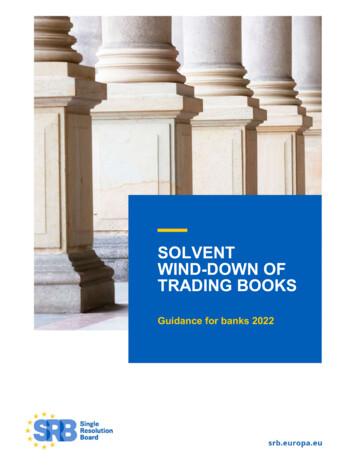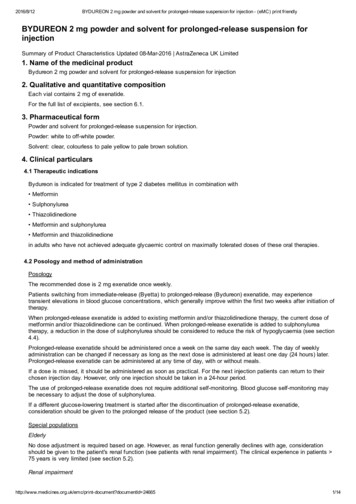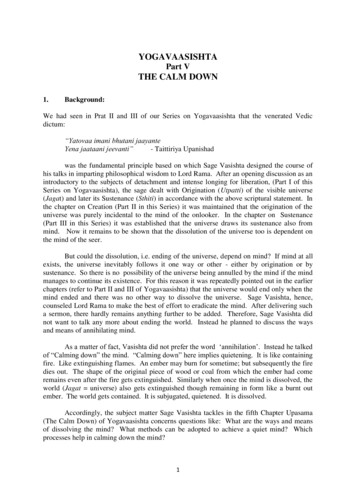
Transcription
SOLVENTWIND-DOWN OFTRADING BOOKSGuidance for banks 2022
Table of contents1. Introduction31.1. Purpose and Objectives31.2. Background41.3. Scope of application41.4. Expectations51.5. Timeline of application52. Deliverables and technical aspects82.1. Data and granularity82.2. Interdependencies102.3. Exit strategy taxonomy112.4. Detailed expectations for SWD plan122.5. Detailed expectations for the SWD Playbook122.6. Underlying assumptions on idiosyncrasy and market conditions142.7. Cost taxonomy152.8. Further definitions193. Expectations – Solvent wind-down of the trading books193.1. Solvent wind-down plan and supporting analyses203.2. Information provision223.3. Solvent wind-down plan execution24Single Resolution BoardTreurenberg 22T 32 2 490 30 00B-1049 Brussels, BelgiumE srb-info@srb.europa.eu@EU SRBsrb.europa.eu
Single Resolution Board I Solvent wind-down of trading books – Guidance for banks 2022AcronymsAVAAdditional valuation adjustmentBRPBusiness reorganisation planBRRDBank Recovery and Resolution DirectiveBUBanking UnionCBCCounterbalancing capacityCFCritical functionCSACredit support annexEfBSRB’s ‘Expectations for Banks’EUEuropean UnionFMIFinancial market ancial Stability BoardIRTInternal resolution teamISDA MAInternational swaps and derivatives association Master AgreementMISManagement information systemNRANational resolution authorityPRSPreferred resolution strategySRBSingle Resolution BoardSRMRSingle Resolution Mechanism RegulationSWDSolvent wind-downRWARisk-weighted asset 2
Single Resolution Board I Solvent wind-down of trading books – Guidance for banks 2022 31. Introduction1.1. Purpose and ObjectivesThe SRB published the Expectations for Banks (EfB) document in April 2020 in order to assist banks under itsremit to ensure an appropriate level of resolvability. The document sets out the necessary steps and initiativesfor banks to take, structured along seven principles, in order to ensure they are resolvable and to demonstratetheir preparedness for a potential resolution.The current guidance1 provides more details to banks2 on how to demonstrate resolvability in relation toPrinciple 7.1 of the EfB (“Structure, complexity and interdependencies”), in particular with regard to the sizeand complexity of the trading books3. For certain banks, the size and complexity of their trading books couldimpede the credible and feasible implementation of their envisaged resolution strategies.The solvent wind-down (SWD) of derivatives and trading books is an approach that can be used for exitingtrading activities in an orderly manner and avoiding posing any risks to financial stability. The lack of a credibleSWD plan may jeopardise the credibility and feasibility4 of the resolution strategy of any institution with materialtrading books.SWD of trading books is a tool also relevant for banks under business as usual, and as a recovery option, soit is expected that banks already have some capacity to wind down their trading activities in an orderly way ifneeded. For the purpose of this guidance, however, the focus is on the SWD as an element of resolutionstrategies, both in resolution planning and in post-resolution. For example, it could act as a reorganisationmeasure in the business reorganisation plan (“BRP”) (EfB Principle 7.3), and as a way to generate liquidity5,reduce RWA to facilitate the reorganisation and mitigate impact on the financial system by limiting stress and1This publication is not intended to create any legally binding effect and does not in any way substitute the legal requirements laid downin the relevant applicable European Union and national laws. It may not be relied upon for any legal purposes, does not establish anybinding interpretation of EU or national laws and does not serve as, or substitute for, legal advice. This document may be subject tofurther revisions, including due to changes in the applicable EU legislation. The SRB reserves the right to amend this publication withoutnotice whenever it deems appropriate, and it shall not be considered as predetermining the position that the SRB may take in specificcases, where the circumstances of each case will also be considered.2For the purposes of this document the term “banks” refers to entities and groups that fall under the SRB’s remit.3EfB 7.1 principle sets out that: “Banks have identified, reduced and, where necessary, removed sources of undue complexity in theirstructure, which pose a risk to the implementation of the resolution strategy. Banks are expected, where necessary and proportionatein the specific cases, to: [.] reduce the complexity and size of the trading book if this is necessary to apply the resolution tools”.4As defined per SRMR Article 10(3).5Not leading to any SWD specific liquidity expectation at this point, for details on applicable expectations for liquidity and funding inresolution, please refer to relevant guidance.
Single Resolution Board I Solvent wind-down of trading books – Guidance for banks 2022 4contagion in the financial markets6. On account of the size and complexity of banks’ trading books, SWDplanning would further improve banks resolvability.This document sets out the scope and minimum expectations for SWD planning and potential execution, withthe main objectives to (i) adequately prepare, develop and maintain banks’ capabilities (including, but notlimited to funding needs in resolution and post resolution) for the planning of a SWD in resolution, and (ii) toensure execution capabilities of the SWD plan in a reasonable timeframe.The application of this operational guidance to each bank may be adapted to individual specificities, taking intoaccount the proportionality principle, and based on a dialogue between each bank and its internal resolutionteam (IRT).1.2. BackgroundThe SRB SWD guidance for banks follows the work initiated by the Financial Stability Board (FSB)7 on the“solvent wind-down of derivatives and trading portfolios” published in 2019. This guidance also reflects regularexchanges between the SRB and the supervisory and resolution authorities from jurisdictions outside theBanking Union where banks have large trading activities (e.g. the Prudential Regulation Authority and FederalDeposit Insurance Corporation). This guidance builds upon analysis conducted by the SRB as part of a pilotconducted with certain banks, surveys and two workshops with the industry (in October 2019 and April 2021).This guidance aims at ensuring a level playing field among the banks concerned and seeks alignment withother jurisdictions where relevant.1.3. Scope of applicationThis document provides additional operational guidance for banks under SRB’s remit with material tradingactivities. All G-Sibs are expected to work on SWD planning as a RPC 2022 priority. Other banks will beidentified and approached in the course of 2022 following a further assessment of the significance of theirtrading books, to work on SWD planning as a RPC 2023 priority.In terms of activities in scope, all trading activities booked in trading books are included in the SWD exercise,while other assets such as loans in the banking book are not at this stage. Banks should provide their viewson the importance of certain desks and market activities for the bank business model (for instance, desksdirectly supporting critical functions such as retail activities, or desks supporting core business lines as beingamong main contributors to profitability or liquidity), for key dependencies towards global and national market6BRRD Articles 31(1), 31(2)(b).7See 2019 discussion paper, df .
Single Resolution Board I Solvent wind-down of trading books – Guidance for banks 2022 5activities (e.g. hedging desk, funding desk, etc.), and towards external counterparties (as a provider of marketmaking or clearing activities). The objective is to understand the challenges and potential impediments ofwinding down the underlying books or desks in order to determine the appropriate sequencing of a potentialwind-down and any desks and books to be ultimately kept in the resolved entity, if any. The bank should reflectin its analysis past, current and foreseen wind-down experience of trading books.1.4. ExpectationsInstitutions with material trading books are expected to develop a granular plan (an SWD plan) and ex-antecapabilities to wind down their trading books. Where winding down of trading books is involved, this will requirecareful planning and analytical capabilities including: A plan outlining the different segments and the associated exit strategies for its trading activities andthe potential financial implications; Information provision on SWD planning such as capacity to update the plan in a timely manner, usingbusiness as usual (BAU) tools, systems and infrastructures as much as possible; The capabilities to execute the wind-down, included in a SWD playbook that would focus ongovernance, HR and communication defined in line with the FSB discussion paper8.1.5. Timeline of applicationG-Sibs are expected to prepare to plan and ensure that capabilities are ready to deliver “Day-1” expectationsin 2022, while other banks approached in 2022 are expected to deliver on these in 2023. Banks should takeall the necessary steps to ensure that all “Day-1” SWD-related expectations are implemented on time. Banksare then expected to further demonstrate their capabilities to operationalise and test the SWD plan throughannual exercises, to enhance and maintain the SWD playbook and to build upon the lessons learnt in aniterative approach, until reaching a satisfactory level of compliance with expectations. It means being able tofully deliver the expectations set in the SWD guidance and adapt the plan to evolving market situation, incoordination with the respective IRT, with the objective of achieving horizontal consistency and a level playingfield.8FSB includes the following regarding “playbooks”: “[ ] some firms have adopted playbooks to help provide clarity on the necessarysteps and actions of the solvent wind-down strategy, both in recovery and in resolution, including, for example, identification of key signoff and escalation points, parties involved in the decision-making in a solvent wind-down, their responsibilities in the execution of asolvent wind-down and communication with relevant stakeholders.”
6Single Resolution Board I Solvent wind-down of trading books – Guidance for banks 2022Table 1. Overview of Day-one and steady-state expectationsDeliverablesSWD PlaybookSWD plandesigningstrategiesDay-one expectations Description of governance structures and organisation for thepurpose of SWD (approximate steps/timelines, HR needs andspecial arrangements, communication)– SWD plan – Exitcosts TimingEnd of 2022(G-Sibs)End of 2023(others)Steady-state expectations Comprehensive and detailed playbook with upgrade from Day-1 playbook(clear procedures/escalation protocols and decision-making process, systemsand infrastructures)TimingEnd of 2023(G-Sibs)End of 2024(others)Comprehensive upgrade from Day-one requirementsCore analysis with supporting metrics: incorporate latest market developmentwithin one monthLatest impacts on balance sheet within five working daysRefined identification of interdependencies and residual positionsEnd of 2023(G-Sibs)End of 2024(others)Comprehensive upgrade from Day-one requirementsAdditional value adjustments (AVA) calculations and reporting per eachsegment (incl. the calculations and reporting of each individual AVAcomponent9)Full periodic reporting capacity for planning and execution purposesFull internal computation of in-house metrics (if applicable)Capacity to implement full exit costs updates with fresh data on periodic basis(minimum quarterly)End of 2023(G-Sibs)End of 2024(others)Comprehensive upgrade from Day-one requirementsExhaustive and accurate operational costs estimations for SWD (during 24months)Reflection of different assumptions and scenarios in operational costsestimationsFull reporting and data update capacityEnd of 2023(G-Sibs)End of 2024(others)Comprehensive upgrade from Day-one requirementsFull capacity for identifying risks and impacts on potential losses (by riskcategories)Comprehensive risk reduction strategy executable in a timely mannerEnd of 2023(G-Sibs)End of 2024(others)Trading book segmentation and identification of exit strategies bysegment with narrative and sequencingCore analysis with supporting metrics: incorporate latest marketdevelopment within three monthsLatest impacts on balance sheet within four weeksInitial identification of interdependencies and residual positionsMid-2022(G-Sibs)Mid-2023(others) Assessment of capabilities in BAUIdentification and reasoning of estimation/modelling methodologiesfor direct and indirect exit costsMid-2022(G-Sibs)Mid-2023(others) SWD planOperationalcosts– Comprehensive identification, description and breakdown of alloperational costsInitial costs estimation (one-off and BAU costs at segment level)Mid-2022(G-Sibs)Mid-2023(others) SWD – Riskbased costs Initial assessment at (most appropriate) segment level with initialsets of risk indicatorsMid-2022(G-Sibs)Mid-2023(others) 9Based on the core approach of the Commission Delegated Regulation (EU) 2016/101 of 26 October 2015 supplementing Regulation (EU) No 575/2013 of the European Parliament and of the Council with regardto regulatory technical standards for prudent valuation under Article 105(14)
7Single Resolution Board I Solvent wind-down of trading books – Guidance for banks 2022SWD – RWA,capitalandliquidity impacts Market risk reduction estimateInitial estimation of counterparty credit risk and operational riskreductionInitial capital impactsShort-term and long-term impact of SWD plan on liquidityMid-2022(G-Sibs)Mid-2023(others) Comprehensive upgrade from Day-1 requirementsFull estimates of market, credit and operational risks reduction and capitalCapacity to provide market, counterparty credit and operational RWA forremaining positionsCapacity to monitor liquidity during SWD executionFull identification of factors impacting liquidity for SWD purposesEnd of 2023(G-Sibs)End of 2024(others)
Single Resolution Board I Solvent wind-down of trading books – Guidance for banks 2022 82. Deliverables and technical aspects2.1. Data and granularitySWD planning requires a variety of qualitative and quantitative information. This section provides detailand expectations on the data that banks will use to produce their SWD plans and analysis.First, banks should use trading data, information and metrics using current ‘business-as-usual’ systems tofit the set of dimensions relevant for SWD planning, with the objective of improving the quality of futureinformation submissions to the SRB if this is not feasible from day one. Relying on business as usual systemsshould ensure the operational capacity to execute such plan in case of resolution.The guidance also refers in many instances to the most ‘relevant segment’. Banks are encouraged to provideinformation on a granular level in light of the information available. In principle, information in the SWD planshould aim for the desk level10, but banks are encouraged to use a more appropriate segment if more relevant,such as a business unit if they have their own internal segmentation of activities. For example, in some specificcases, such as providing Credit Valuation Adjustment (CVA), such a level of granularity might not beachievable and banks can provide data using a different segment, for example counterparty level in thisinstance.Once the most appropriate segmentation of the activities has been determined, ideally at desk level, banksare expected to provide a short desk ‘identity card’, where banks report the desk name, location, legal entity(including outside the Banking Union), asset class and trade types (e.g. Fixed income flow, FX options, equityderivatives ).The SWD plan needs to include information on the initial snapshot as well as on the target snapshot: The initial snapshot should provide a description of the trades and desk at the starting point of thewind-down period, including both positions subject to SWD strategy, as well as positions targeted forthe ‘rum’ portfolio (i.e. remaining positions in the trading books, not subject to the SWD); While the target snapshot would provide only a description of the trades and desks that the bank isexpected to still own after the wind-down period.An impact assessment over time is equally important. Given the expected length of the SWD exercise,the reporting should also be more dynamic than just having the starting and the ending positions. Banks areexpected to forecast and document the impacts on capital and liquidity and the need for financial resources atintermediary, regular terms, with a quarterly minimum frequency to reflect the expected evolution and pace of10Similar to the split proposed by the Fundamental Review of Trading Books (Basel Committee on Banking Supervision, 2019)
Single Resolution Board I Solvent wind-down of trading books – Guidance for banks 2022 9executing the unwind strategy. These milestones might not be as granular as the initial and final snapshots,but could include, at entity level, the evolution of risk and costs.Banks should consider their trading book positions as either cancellable11, transferable or saleablepositions and further split into categories based on product types and business lines as well as byexit strategies (see subsequent section “Exit strategy taxonomy”). Banks are expected to have performeda granular segmentation of their books based on the key characteristics that will affect the exit strategy. Thismay include (i) product type; (ii) counterparty type; (iii) underlying-type; (iv) master agreements’ (MA) creditsupport annexes (e.g., CSA12 for ISDA MA) and long form confirmations; (v) currency, (vi) maturity and (vii)first order sensitivity to the main underlying (delta, PV01 depending on which is the most relevant for theproduct type). For all trading book positions in scope for SWD, banks are expected to also assign an exitstrategy to each segment, including timing and cost of exit. In addition, where the strategy would be novation13or sale, the institution is expected to have identified potential acquirers (by name or type) of the portfolio whenfeasible.The target portfolio can be seen as a forecast of the rump portfolio. The rump portfolio represents theresidual portfolio, which is expected to remain on the financial institution’s trading book after the application ofthe SWD plan. The target portfolio represents all ‘sticky’ trades that the bank will not be able to dispose of,because of their complexity, illiquidity, lack of attractiveness, trade-off between maintenance and sell-off costs,or the existence of any dependencies blocking the possibility for winding down. In resolution, banks shouldalso estimate the value of the rump portfolio, as it is particularly relevant for these most illiquid, less marketableassets and thus representing the highest potential losses.The rump portfolio should be further divided into non-discretionary rump and discretionary rump. Thenon-discretionary rump includes positions that the bank believes it would be unable to liquidate at reasonablecost, despite all reasonable efforts, as well as positions which the bank holds to support such positions (butwhich it would be able to exit otherwise). The discretionary rump, on the contrary, includes positions which thebank believes can be liquidated, but where the cost would be greater than the full cost of maintaining suchpositions to maturity or to some future point14.Several metrics of interest have been identified with respect to initial and target portfolios. In particular,the size, complexity and associated risks are the most important; in addition, potential haircuts and related1112For callable trades and/ or trades for which the term sheet allows for early termination.Document that defines the terms for the provision of collateral by the parties in derivatives transactions. It is one of four parts of astandard contract or master agreement developed by the International Swaps and Derivatives Association (ISDA)13Novation entails the termination of a given contract and its replacement with a new economically equivalent contract, but with a differentcounterparty.14In line with the FSB discussion paper on SWD of derivatives and trading portfolios
Single Resolution Board I Solvent wind-down of trading books – Guidance for banks 2022 10costs should be taken into account. Banks are expected to include current capital requirements for the nondiscretionary and discretionary rump portfolio.To better capture the size of the portfolio, banks are expected to report on the book value of positionsheld by the desk. The SRB would recommend the use of the fair value – most likely available from RiskManagement areas, or at least the market value used as the regular business valuation if the former is notavailable. These metrics should leverage on front office valuation from the business as usual system, and will,especially for less liquid trades, provide a more realistic view of the real value of the portfolio.Trade complexity is one of the determining factors affecting the SWD strategy. More complex positionscan be assumed to be less liquid, to hold a bigger risk of being inadequately priced, and/or to require moretime to wind down, making them particularly important to flag at planning phase for the SWD exercise. Tobetter assess the complexity of the trades held by a given desk, banks are expected to also report the fairvalue amount of the positions falling under the level 3 of the IFRS13 accounting standards, as well as thefirst order sensitivity to the main underlying/ risk factor (delta, PV01 depending on which is the most relevantfor the product type).2.2. InterdependenciesBanks should consider external and internal interdependencies. In particular, they should not elaborateSWD plans for each desk or business line independently without considering a general strategy or sequencing.More generally, the SWD strategy needs to highlight all existing interdependencies, especially with regardto critical functions and critical services, and on core business lines and essential services, building on workalready performed on the institution’s service delivery model and its mappings15, already expected as part ofthe Identification of Operational Interdependencies and operational continuity guidance16, in line with EfBdimension 4 “Operational continuity in resolution and access to FMI services”. The impact of SWD on the restof the group could be evaluated in terms of the operational and financial interdependencies including FMIaccess, shared services, IT infrastructure, cost allocation, liquidity, business model and revenues. This isespecially pertinent in the case of universal banks or when parts of banks’ trading activities need to bemaintained for the rest of the group, such as the funding desk or basic FX activities.15These cover the mappings of relevant services, staff and operational assets to critical functions and core business lines needed for theeffective implementation of the resolution strategy and any consequent 20transfer%20tools%20FINAL.pdf
Single Resolution Board I Solvent wind-down of trading books – Guidance for banks 2022 11Furthermore, as part of the SWD strategy, banks need to consider the sequence of the actions, tohighlight any interplay between desks or potential clashes of exiting different markets at the same time.2.3. Exit strategy taxonomyA solvent wind-down of derivatives and trading books could be achieved through several exit strategies thatmay be used singularly or in combination17: Close-out or termination of position prior to maturity Negotiate Closeout (individual trades or by counterparty); Bilateral Tear Up; Cash Security Sale or Buyback.Contractual run-off (allowing contracts to run to maturity – within the wind-down period – withoutbeing replaced or renewed.) Contractually Matures (3rd Party); Contractually Matures (Intra-Group).Auction/ Transfer/ Novation of positions (Termination of a contract or its partial replacement with anew contract.) Package & Sell; Return of Collateral; Securitisation.Compression or Consensual tear-up (Replacing a portfolio of derivative contracts with aneconomically equivalent portfolio with a lower exposure expressed in terms such as gross notionaloutstanding.) Rump18 (Remaining/residual portfolio after performing wind-down exercise) Discretionary rump (i.e. positions the firm believes can be liquidated but where the cost to dowould be greater than the full costs of maintaining positions to maturity or to some future datewhere liquidation would be optional); Structural rump (positions that the firm believes it would be unable to liquidate under certainscenarios despite all reasonable efforts).17The proposed taxonomy is inspired by the FSB discussion paper on SWD of derivatives and trading portfolios.18While this does not qualify as an exit strategy by definition, this is part of the taxonomy banks should use to classify portfolios.
Single Resolution Board I Solvent wind-down of trading books – Guidance for banks 2022 122.4. Detailed expectations for SWD planSWD plans are made of two components: Solvent exit strategies per segment with a narrative explaining the foreseen reorganisation,sequencing, etc. This part is expected to be rather stable over time, and should be seen as thebackbone of the plan; The underlying SWD analysis with corresponding supporting metrics such as FTEs needed, timing,exit and operational costs etc. This part is expected to be more volatile depending on underlying inputdata and latest state of the portfolio (considering remaining time to maturity, new, amended andcancelled trades etc.).As part of their SWD planning, banks are expected to develop the capabilities to perform a full refresh (henceboth components described above) of the plan taking into consideration the latest market conditions, includingthe selection of exit strategies amidst changing market conditions, on a timely basis.For the first year of introduction of the new policy, banks are expected to submit their first SWD plan within amaximum of five months following the request date, to be considered as the time of reception of thisoperational guidance and before 30 June 2022, whichever comes first. The development of the SWDstrategy is a multi-year project and SWD plans are expected to be progressively updated and finalised.Steady-state expectations for such re-submissions are for them to be delivered on a more timely basis,within two months of the announcement of a material restructuring of the trading activities of the bank.Banks are expected to also develop the capacity for a ‘quick refresh’ to update the second componentdescribed above. Day-one expectations are for banks to be able to conduct such a quick refresh within fourweeks. In the steady state, banks are expected to have the capacity to refresh the plan in a maximum of fiveworking days.2.5. Detailed expectations for the SWD PlaybookThe SWD playbook is defined, in line with the FSB discussion paper, as a handbook developed by a bank,which aims to help provide clarity internally on the necessary steps and actions of the solvent wind-downstrategy. This includes, but is not limited to, the identification of key sign-off and escalation points, partiesinvolved in the decision-making in a solvent wind-down, their responsibilities in the execution of a solvent winddown and communication with relevant stakeholders. While the SWD plan is meant to outline the differenttrading segments and the associated exit strategies for their trading activities and the potential financialimplications, the SWD playbook is meant to be a more static document covering governance, HR andcommunication. The structure of the SWD playbook should be consistent with banks’ other recovery andresolution playbooks and include references to these and other operational and strategic documents asnecessary. In particular, banks are invited to:
Single Resolution Board I Solvent wind-down of trading books – Guidance for banks 2022 13(a) Keep strategic and operational documents up-to-date on regular basis. The documents should containclear and effective description of the procedures, system and infrastructure, while seniormanagement/committees are expected to be fully involved for the benefit of the decision-makingprocess and related delivery of tasks;(b) Keep the communication plan (for business continuity or resolution purposes) aligned with the stepsdescribed in the solvent wind-down plan (where applicable);(c) Investigate synergies with other playbooks.Day-one expectations: banks shall work on a first draft of the SWD playbook(s), where the following elementsare described and detailed:i.Existing governance structures and organisation for the purpose of a SWD implementation andcommunication:a. Flowchart on key roles involved in the decision making of a SWD, and their responsibilities;b. Flowchart on governance from decision, to execution, to communication with key sign off andescalation points.Reference to existing operational and strategic documents is accepted, as long as it is relevant in the contextof SWD of trading books:ii.When using existing operational and strategic documents, banks update the content and assess ifadditional material and information are necessary and applicable for SWD in resolution. Banks areexpected to demonstrate that such assessment has been completed;iii.Evaluate HR needs and any special arrangements such as retention
trading books. SWD of trading books is a tool also relevant for banks under business as usual, and as a recovery option, so it is expected that banks already have some capacity to wind down their trading activities in an orderly way if needed. For the purpose of this guidance, how











